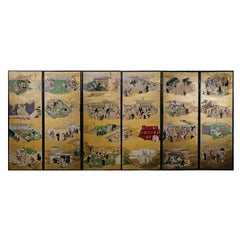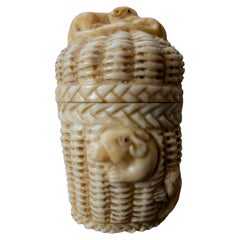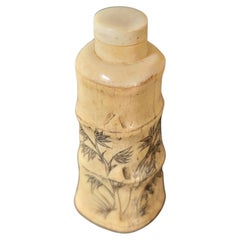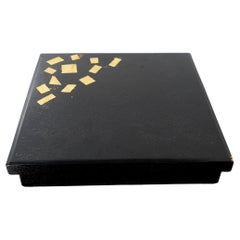Want more images or videos?
Request additional images or videos from the seller
1 of 13
Japanese Carved Netsuke Humanoid Dragon by Yamada Hojitsu法實, Edo Period
Price:$750
$1,250List Price
About the Item
- Dimensions:Height: 2 in (5.08 cm)Width: 1.5 in (3.81 cm)Depth: 0.75 in (1.91 cm)
- Materials and Techniques:
- Place of Origin:
- Period:
- Date of Manufacture:19th Century
- Condition:Wear consistent with age and use. Wear consistent with age and use.
- Seller Location:Norton, MA
- Reference Number:1stDibs: LU5848239560082
About the Seller
5.0
Gold Seller
Premium sellers maintaining a 4.3+ rating and 24-hour response times
Established in 2000
1stDibs seller since 2021
121 sales on 1stDibs
Typical response time: 1 hour
Authenticity Guarantee
In the unlikely event there’s an issue with an item’s authenticity, contact us within 1 year for a full refund. DetailsMoney-Back Guarantee
If your item is not as described, is damaged in transit, or does not arrive, contact us within 7 days for a full refund. Details24-Hour Cancellation
You have a 24-hour grace period in which to reconsider your purchase, with no questions asked.Vetted Professional Sellers
Our world-class sellers must adhere to strict standards for service and quality, maintaining the integrity of our listings.Price-Match Guarantee
If you find that a seller listed the same item for a lower price elsewhere, we’ll match it.Trusted Global Delivery
Our best-in-class carrier network provides specialized shipping options worldwide, including custom delivery.You May Also Like
Antique Japanese Inro by Shigehide Edo Period
Located in Atlanta, GA
This exquisite four-case lacquered inro was dated to the latter part of 18th century to early 19th century (Edo period) and made by Shigehide. The opposite sides of the inro together features a lavish flower arrangement in a bamboo basket (ikebana). The detailed craftmanship was a true pleasure to behold. Mostly Takamaki-e (high relief) were used to texturize the delicate petals of the chrysanthemums, on which different shades of gold were used to create contrast. Raden (mother of pearl) shells were also used to highlight some leaves, rendering the piece an interesting balance of color and material. The interior was completed in a mottled gold finish. It was signed Shigehide on the bottom with a Kao. There is a small carved rabbit ojime bead...
Category
Antique Late 18th Century Japanese Japonisme Lacquer
Materials
Wood, Lacquer
Japanese Inro by Koma Koryu Edo Period
Located in Atlanta, GA
A four-case lacquered inro by Koma Koryu circa 19th century late Edo period. The inro features a pair of Chinese mandarin duck resting under a bundle of blooming irises on the pond. ...
Category
Antique 19th Century Japanese Japonisme Lacquer
Materials
Wood, Lacquer
Japanese Lacquer Chest, Edo Period
Located in Greding, DE
Small rectangular Japanese chest with gold lacquer decoration in the form of leaf tendrils. The chest is decorated with cut-out and ornamentally engraved fittings on the corners and ...
Category
Antique 18th Century Japanese Edo Decorative Boxes
Materials
Brass
Japanese Lacquer Maki-E Scroll Box Fubako by Kansonsai Edo Period
Located in Atlanta, GA
A Japanese lacquered wood fubako (a box to store document or small scroll painting) circa late 18th century of Edo period. The rectangular box features a deep lid with rounded corners and recessed mid-edge and a lower box with two bronze medallion rings and tasseled silk ties. The surface of the fubako was elaborately decorated with hiramaki-e and a low takamaki-e on a mottled Mura-nashiji background. The motifs on the lid depict branches of Japanese pine with finely rendered needles on the lower part; on the upper part, it showcases fruited persimmon branches. Two different shades of gold fundame were used to contrast the design and augmented by scattered gold kirigane to highlight some of the leaves. The design continues and cascades down to all sides of the lid as well as the walls of the box. The two bronze medallions appear original to the box and the silk ties show significant fading from the age. This Fine fubako is signed on the lower wall "Kanshosai" in Kanji with a kao mark. All the trims were finished in gold fundame and the interiors a dense nashiji in gold.
Kanshosai is the mark of the distinguished lacquer artist Lizuka Toyo I who also signed his work "Toyosai". He was active in the second half of the 18th century during Edo period, employed by Hachisuka Shigeyoshi (1738-1801), daimyo of Awa on Shikoku Island. Although most survived work bearing his marks are inros, he was also known to decorated trays and other larger objects...
Category
Antique Late 18th Century Japanese Edo Lacquer
Materials
Wood, Lacquer
Exquisite Japanese Lacquer Maki-e Hand Box Kobako Edo Period
Located in Atlanta, GA
An early Japanese lacquer Maki-e decorated kobako (small storage box) circa 18th century (Edo period). Based on its form and size, this kobako was possibly used as a Chabako to store the accoutrements for chado (tea ceremony). The lidded box is of rectangular form with bevel design on all edge that softens the appearance. The entire surface was densely covered with a background of nashiji. Elaborate Maki-e techniques were used on each side to showcase a distinct landscape or floral design within a cartouche panel. On the surface of the lid, a mountainous landscape rises from the edge of the water. The poetic composition is akin to a traditional ink scroll...
Category
Antique 18th Century Japanese Edo Lacquer
Materials
Lacquer
Japanese Antique Buddhist Shrine Box "Zushi", Edo Period '1603-1868'
Located in Hitachiomiya-shi, 08
This antique Buddhist shrine box was crafted in the Edo Period (1603-1868).
Known in Japan as a “Zushi,” it served as a small sanctuary to enshrine Buddhist figures, scriptures, or ...
Category
Antique Mid-17th Century Japanese Edo Decorative Boxes
Materials
Cedar
$680
H 10.79 in W 9.22 in D 4.18 in
Edo-Period Lacquerware Chest
Located in New Orleans, LA
Edo-Period Lacquerware Chest
19th-century
This exquisite chest, inspired by Hasami-Bako travel trunks, is a striking example of Japanese lacquerware. The hiramaki-e technique—applie...
Category
Antique 19th Century Japanese Edo Decorative Boxes
Materials
Gold
Japanese Edo Period Igarashi School Long Lacquer Box, Tanzaku-Bako
Located in Austin, TX
A stunning Japanese Edo period lacquer tanzakubako, box for poem cards, late 18th-early 19th century, Edo Period, Japan.
Attributed to the Igarashi School, this box is masterfully ...
Category
Antique Early 19th Century Japanese Edo Lacquer
Materials
Mother-of-Pearl, Lacquer
Japan, Pair of Hokai boxes in lacquered wood, Edo period, 1829
Located in PARIS, FR
Japan, Pair of Hokai boxes in lacquered wood, Edo period, 1829
Japan, Rare Pair of Hokai boxes in lacquered wood, Edo period, dated Bunsei 12, 1829.
Hokai boxes are traditionally use...
Category
Antique 19th Century Japanese Chinoiserie Decorative Boxes
Materials
Lacquer
$9,116 / set
H 16.93 in W 18.71 in D 18.71 in
A Japanese Edo Period Lacquer Kogo (Incense) Box, late 17/early 18th Century
Located in Spencertown, NY
Early Japanese Lacquer Incense Box (Kogo) Late 17thc. Of rectangular form with soft corners, decorated with a diaper pattern in gold lacquer on a brownish black ground, with pewter r...
Category
Antique 17th Century Japanese Edo Decorative Boxes
Materials
Pewter
$3,500
H 2.5 in W 3.5 in D 3 in
More From This Seller
View AllJapanese 18th Century Tsukinami-e 6 Panel Floor Screen, Edo Period
Located in Norton, MA
A Japanese 18th Century Tsukinami-e 6 Panel Floor Screen depicts the Activities of the Twelve Months of the Year, mineral pigments on gold leaf, mounted on wood panels with 6 frames...
Category
Antique 18th Century Japanese Edo Decorative Boxes
Materials
Gold Leaf
Japanese Carved Bone Pillbox Inro
Located in Norton, MA
Presenting an astonishing Japanese Antique Carved Bone Pillbox Inro, museum quality with the amazing carving skill depicting rats on the lid and body and the relief weaved basket pat...
Category
Early 20th Century Japanese Decorative Boxes
Materials
Bone
Japanese Carved Bone A Bamboo-Form Snuff Bottle
Located in Norton, MA
Presenting an astonishing Japanese Antique Carved Bone bamboo-form snuff bottle, museum quality.
Dimension: 2.5" H x 1 " Dia.
Condition: Excellent Condition
Category
Early 20th Century Japanese Decorative Boxes
Materials
Bone
Japanese late Meiji period Large Organizer Lacquered Box, Ric.053
Located in Norton, MA
Japan, late Meiji period or later, a large black square organizer box and cover, decorated with geometric squares in gold on the cover
Category
Antique 19th Century Japanese Decorative Boxes
Materials
Lacquer
Japanese late Meiji period A Large Organizer Red Lacquered Box, Ric.052
Located in Norton, MA
Japanese late Meiji period A Large Organizer Red Lacquered Box, decorated with irises and butterflies in gold and black.
Category
Antique 19th Century Japanese Decorative Boxes
Materials
Lacquer
Japanese Carved Bone Woven Basket Inro, early 20th Century
Located in Norton, MA
Intricately carved inro in the form of a woven basket. Quality craftsmanship. Opens into two pieces, held together with a rust-red silk string. Made of nat...
Category
Early 20th Century Japanese Decorative Boxes
Materials
Bone
Recently Viewed
View AllMore Ways To Browse
Japanese Carved Bedroom Furniture
Antique Hand Carved Ivory
Antique Japanese Ivory
Signed Netsuke
Toggle Chinese
19th Century Japanese Ivory
Carved Ivory Box
Carved Ivory Dragon
Dragon Netsuke
Ivory Netsuke
Japanese Ivory Netsukes
Large Sterling Silver Box
Needle Case
Antique Brass Heart
Antique Paper Mache Boxes
Art Deco Candy
Brass Engraved Box
Burma Box



